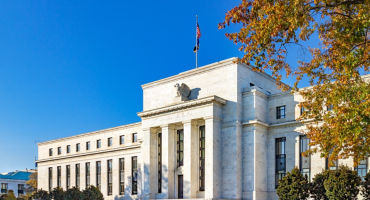- Investment Specialist
Skip to main content
- Funds
- Insights
- Capabilities
- About Us
- My Account
United States, Institutional
Changechevron_rightThank you for your registration
You will shortly receive an email with your unique link to our preference center.
The views expressed are those of the authors at the time of writing. Other teams may hold different views and make different investment decisions. The value of your investment may become worth more or less than at the time of original investment. While any third-party data used is considered reliable, its accuracy is not guaranteed. For professional, institutional, or accredited investors only.
At time of writing, investors and market commentators are focused on the impact of (still) high inflation and subsequent monetary policy decisions on bond markets but they appear to have overlooked the potential consequences for currency risk. Yet, in our view, the new economic era we have entered entails not only more uncertainty and volatility in interest rates but also greater fluctuations in exchange rates. Hence, we believe understanding currency moves and how they impact economies can be an important asset in navigating increasingly volatile markets.
Currency intervention is a monetary policy action taken to moderate the pace or extent to which a currency appreciates or depreciates. This is done by changing the supply of the local currency and actively buying or selling foreign currencies at scale to reach the desired exchange rate. It is most often undertaken when the level of the local currency exchange rate is deemed to have moved out of alignment with underlying economic fundamentals. Policymakers buy or sell national reserves to stabilise the economy and control inflation by putting a stop to what is perceived to be excessive currency strengthening or weakening. While the line between currency intervention and manipulation can sometimes be blurred, large-scale interventions generally aim to address a broadly recognised imbalance in markets and often involve international cooperation or agreement. Occasionally, however, governments are accused of outright manipulation, attempting to unofficially distort the value of their currency to achieve a specific economic objective, most notably to (re)gain competitiveness in global markets and boost exports.
Lessons from the past
To be clear, intervention by policymakers to prop up or strategically devalue a currency is not new. As an example, in 1992, the UK withdrew sterling from the European Exchange Rate Mechanism (ERM) in a bid to stop speculative selling of the currency (an event known as “Black Wednesday”). At the time, the UK was slowly emerging from a steep recession caused by factors such as low competitiveness, high inflation and persistent current account deficits. However, policymakers kept interest rates high to prop up the value of sterling. When market participants became concerned that the currency’s exchange rate did not reflect these weaknesses, the monetary authorities responded with further rate hikes and then large-scale currency interventions. When these rate hikes and interventions became unsustainable, the UK abandoned the ERM, prompting a large-scale devaluation (Figure 1). While a brutal shock, it ultimately increased the UK’s competitiveness in global markets and spurred economic growth.
Similarly, other ERM currencies, most notably the Italian lira and Spanish peseta, went through various rounds of devaluations against the German mark, enabling them to maintain export competitiveness. And back in the 1980s, the G7 countries sought a strategic devaluation of the US dollar through coordinated efforts (the Plaza and Louvre Accords), with the aim of addressing major imbalances in the global economy.
Since the introduction of the euro, active currency intervention has mostly occurred in emerging markets, most notably in Argentina and Turkey. Among developed economies, the use of active currency management has been limited to Switzerland, as the safe-haven status of the Swiss franc has, at times, posed a risk for the Swiss economy and the effectiveness of its monetary policy.
However, intervention has become more frequent in the last two years. We have seen Japan’s Ministry of Finance step into markets with tens of billions of US dollars to shore up the value of the Japanese yen while the Chinese authorities appear to be allowing the renminbi to float more freely in global markets in an attempt to devalue the currency and improve competitiveness. There has even been speculation that some Trump advisers are in favour of including currency intervention in the US government’s economic toolkit, should the Republican Party regain control of the administration. While on the surface implausible, such a move would be bold and unprecedented in recent history.
The inevitable conclusion is that once a critical mass of countries engage in active currency manipulation, a sort of prisoner’s dilemma ensues: there is no advantage in not taking part. This has potentially significant implications for investors and allocators:
Experts


Weekly Market Update
Continue readingBy
FOMC: Easing into uncertainty
Continue readingOpportunity ahead: Optimism or illusion?
Continue readingFinancing the AI boom: credit markets at a crossroads
Continue readingLow tide, sharp eyes: What to pick up
Continue readingFinding durable value amid shifting currents
Continue readingURL References
Related Insights
Stay up to date with the latest market insights and our point of view.
Thank you for your registration
You will shortly receive an email with your unique link to our preference center

Weekly Market Update
What do you need to know about the markets this week? Tune in to Paul Skinner's weekly market update for the lowdown on where the markets are and what investors should keep their eye on this week.
By

FOMC: Easing into uncertainty
Fixed Income Portfolio Manager Jeremy Forster profiles the Fed's December rate cut, labor market trends, inflation pressures, and the role of anticipated changes to FOMC leaders in 2026.

Opportunity ahead: Optimism or illusion?
Explore our latest views on risks and opportunities across global capital markets.

Financing the AI boom: credit markets at a crossroads
Fixed Income Portfolio Manager Derek Hynes and Fixed Income Investment Specialist Will Prentis examine how the AI financing boom is transforming credit markets and discuss the opportunities and risks it creates for investors.

Low tide, sharp eyes: What to pick up
Fixed Income Managers Campe Goodman and Rob Burn share their outlook for credit in 2026 and discuss how investors can reposition for an environment where opportunities are harder to find.

Finding durable value amid shifting currents
Fixed Income Strategist Amar Reganti and Investment Director Marco Giordano explore how to approach bond investing in 2026. They see durable value for investors who can flexibly adjust to the shifting currents ahead.

Monthly Market Review — October 2025
A monthly update on equity, fixed income, currency, and commodity markets.

Investing in 2026: prepare for inflationary growth
Macro Strategists John Butler and Eoin O'Callaghan share their annual macro outlook and discuss likely implications for markets and investors. They outline four potential scenarios graded by level of probability.

Rapid Fire Questions with Ross Dilkes
In this edition of “Rapid Fire Questions,” fixed income portfolio manager Ross Dilkes shares his views on the Asia credit market—covering the macro outlook, China’s momentum, the most compelling opportunities across the region, and key risks shaping the next 12 months.

Constructive, selective, resilient
Amar Reganti, a member of our Insurance team, explains why he believes insurers should remain selectively risk-on while prioritizing high-quality income and preserving flexibility to add risk as valuations improve.
By

Questioning US credit quality
Fixed income strategist Amar Reganti examines questions surrounding US creditworthiness.
By
URL References
Related Insights
© Copyright 2025 Wellington Management Company LLP. All rights reserved. WELLINGTON MANAGEMENT ® is a registered service mark of Wellington Group Holdings LLP. For institutional or professional investors only.
Enjoying this content?
Get similar insights delivered straight to your inbox. Simply choose what you’re interested in and we’ll bring you our best research and market perspectives.
Thank you for joining our email preference center.
You’ll soon receive an email with a link to access and update your preferences.
Monthly Market Review — October 2025
Continue readingBy